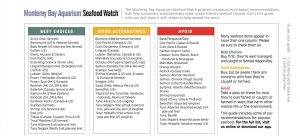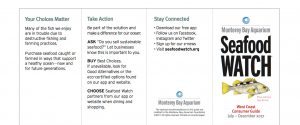BY MADISON RAE | SQ ONLINE WRITER | SQ ONLINE (2017-18)
___________________________________________________________________________
Some fish are infamous for looking unpleasant to eat. Pufferfish are spiny and need to be prepared properly or they can be poisonous. Lionfish are beautiful, but covered in venomous spines. Deep sea fish often look more alien than edible. But fish from a local restaurant or grocery store are perfectly safe, right? Maybe not. You may have heard of people getting mercury poisoning from fish, or problems with overfishing. But how does that affect the average person? What can we do to change the seafood situation for the better, and how can we protect ourselves from potential dangers from innocent looking seafood? There are spreadsheets and organizations telling you which fish are “sustainable,” ecofriendly, and healthy, but it can be so hard to understand their picks and make the best choices for yourself and the environment.
Let’s start with the issue of poisoning via mercury and other toxins. Mercury is a toxic heavy metal that builds up in the tissue of animals that ingest it; it concentrates in the bodies of fish and shellfish. One of the forms that we often find in fish and shellfish is methylmercury, which is a very toxic organic compound. When larger fish eat smaller fish and shellfish, they also accumulate the mercury in their own bodies. When humans eat top predator fish like tuna or swordfish – that have eaten many other fish and accumulated their mercury – they may be eating meat that contains dangerously high levels of mercury or methylmercury.

Less human-centric but equally detrimental to the environment, overfishing is a big environmental issue driving the picks for sustainable fish. Many species have been fished to the point that their populations are very low, pushing prices high and driving the species close to extinction. Environmental groups keep watch for fish species that are being overfished, and suggest alternative species that aren’t as popular but may have similar tastes and textures to lower demand for endangered – and often legally protected – species to take away incentive for fishermen to catch them illegally.
If you’ve ever seen guides like Seafood Watch or Eat These Fish, you know how complicated they can be to use. As Natalie Jacewitz describes in the article “I Want To Eat Fish Responsibly, But the Seafood Guides Are So Confusing!”, finding the best fish choices in stores and restaurants can be incredibly difficult. Many restaurants don’t know where their fish comes from, and even if they do, their vendors may not be truthful; a recent study found that 33% of the seafood from six restaurants in Washington D.C. was mislabeled. In some cases, the mislabeled fish was “closely related or considered acceptable alternatives,” but some rarer cases were low quality or endangered fish species being advertised (and priced) as very expensive species. Therefore, even if you ask the restaurant the specifics of how their seafood was caught and where it came from, you may still end up eating seafood that isn’t safe or is harmful to the environment.
___________________________________________________________________________


Both halves of Seafood Watch’s printable guide for California, available here. All 50 states are available. The National guide can be found here, and the sushi guide here.
___________________________________________________________________________
Each guide has different parameters for their choices. Some may be geared more towards environmental impact, while others focus more on food safety. Seafood Watch focuses most heavily on overfished species and harmful fishing and farming methods, updating their guides regularly and specializing them for each state. Eat These Fish focuses on suggesting good tasting but uncommon alternatives for popular and problematic species. Since restaurants have issues with labeling and sourcing, these guides are most helpful for buying fish from your local markets. There may still be rare issues of unclear sourcing, but it’s the best method available to find healthy and environmentally friendly seafood. Here on the coast, we have innumerable options when it comes to seafood. The Seafood Watch website has printable lists for residents and visitors of each state that can fit inside your wallet (as seen above), and their app can give you sustainable options on-the-go anytime. If we want to keep our seafood variety alive while maintaining our own safety and the health of the environment, every sustainable purchase counts.
This article’s featured image can be found here.
[hr gap=”0″]
Sources:
https://www.sciencedaily.com/releases/2017/04/170425092334.htm
https://peerj.com/articles/3234/
https://www.seafoodwatch.org/seafood-recommendations
http://ocean.nationalgeographic.com/ocean/take-action/sustainable-seafood/
https://en.wikipedia.org/wiki/Mercury_in_fish
http://www.seafoodwatch.org/-/m/sfw/pdf/guides/mba-seafoodwatch-west-coast-guide.pdf?la=en
https://en.wikipedia.org/wiki/Toxic_heavy_metalMBA-SeafoodWatch-West-Coast-Guide
http://www.myrecipes.com/how-to/canned-tuna-guide
http://www.health.com/food/sustainable-healthy-seafood
